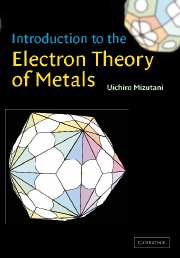Book contents
- Frontmatter
- Contents
- Preface
- 1 Introduction
- 2 Bonding styles and the free-electron model
- 3 Electrons in a metal at finite temperatures
- 4 Periodic lattice, and lattice vibrations in crystals
- 5 Conduction electrons in a periodic potential
- 6 Electronic structure of representative elements
- 7 Experimental techniques and principles of electronic structure-related phenomena
- 8 Electronic structure calculations
- 9 Electronic structure of alloys
- 10 Electron transport properties in periodic systems (I)
- 11 Electron transport properties in periodic systems (II)
- 12 Superconductivity
- 13 Magnetism, electronic structure and electron transport properties in magnetic metals
- 14 Electronic structure of strongly correlated electron systems
- 15 Electronic structure and electron transport properties of liquid metals, amorphous metals and quasicrystals
- Appendix 1 Values of selected physical constants
- Principal symbols (by chapter)
- Hints and answers
- References
- Materials index
- Subject index
14 - Electronic structure of strongly correlated electron systems
Published online by Cambridge University Press: 20 November 2009
- Frontmatter
- Contents
- Preface
- 1 Introduction
- 2 Bonding styles and the free-electron model
- 3 Electrons in a metal at finite temperatures
- 4 Periodic lattice, and lattice vibrations in crystals
- 5 Conduction electrons in a periodic potential
- 6 Electronic structure of representative elements
- 7 Experimental techniques and principles of electronic structure-related phenomena
- 8 Electronic structure calculations
- 9 Electronic structure of alloys
- 10 Electron transport properties in periodic systems (I)
- 11 Electron transport properties in periodic systems (II)
- 12 Superconductivity
- 13 Magnetism, electronic structure and electron transport properties in magnetic metals
- 14 Electronic structure of strongly correlated electron systems
- 15 Electronic structure and electron transport properties of liquid metals, amorphous metals and quasicrystals
- Appendix 1 Values of selected physical constants
- Principal symbols (by chapter)
- Hints and answers
- References
- Materials index
- Subject index
Summary
Prologue
There exists a family of solids, in which the electron–electron interaction plays so substantial a role that the one-electron approximation fails. This is known as the strongly correlated electron system. Historically, De Boer and Verwey were the first to point out, as early as in 1937, that NiO in the NaCl structure should be metallic, since the Fermi level falls in the middle of the Ni-3d band. This already posed serious difficulty in the one-electron band calculations at that time, since NiO is known to exist as a transparent insulator having a band gap of a few eV. Peierls noted in the same year that this difficulty stemmed from the neglect of the repulsive interaction between the electrons and that the electron–electron interaction must be treated beyond the Hartree–Fock one-electron approximation.
Various transition metal oxides, including NiO and various layered perovskite cuprates, the latter being known to undergo a transition to the superconducting state upon carrier doping, have now been recognized as solids typical of a strongly correlated electron system. Their electronic structures and electron transport properties have been extensively studied in the last ten years, i.e., the 1990s. In this chapter, we introduce first the concept of the Fermi liquid theory, which justified the one-electron approximation for electrons near the Fermi level in ordinary metals and alloys, and then extend our discussion to cases where the one-electron approximation fails because of the electron–electron interaction. The Hubbard model is introduced as a model appropriate to describe the short-range motion of electrons transferring from one atomic site to another in competion with the on-site repulsive Coulomb interaction.
- Type
- Chapter
- Information
- Introduction to the Electron Theory of Metals , pp. 432 - 450Publisher: Cambridge University PressPrint publication year: 2001



